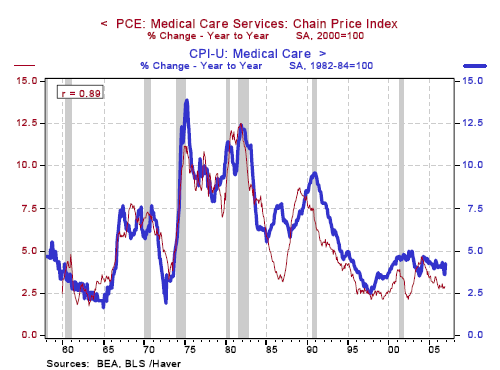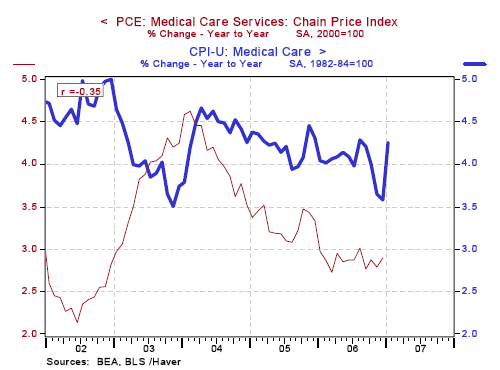US Inflation - The Medical Care Component of Personal Consumption Expenditure Price Index (PCE)
Economics / Analysis & Strategy Feb 28, 2007 - 11:29 AM GMTBy: Paul_L_Kasriel
Among the several economic reports due for publication this week -- new home sales, existing home sales, consumer confidence measures, durable goods orders, preliminary estimate of fourth quarter real GDP, and ISM manufacturing survey results for February, construction outlays for January, and the personal income and outlays report for January-- the Fed's preferred inflation measure will garner a great deal of attention.
The core personal consumption expenditure (PCE) price index, which excludes food and energy, advanced 2.22% in December, representing a deceleration from the 2.44% peak seen in August. This improvement is important because core inflation is heading in the direction of the FOMC's comfort zone of 1%-2%. However, after the January Consumer Price Index (CPI) was reported, there were concerns about the January core PCE price index because it is largely based on the CPI.
The main reason for the anxiety is the fact that the sharp 0.8% increase in medical care prices was responsible for 60% of the increase in the core CPI. Although the PCE price is based on the CPI but there are several differences in terms of scope and weights of components. Medical care expenses (weight was 17.1% in 2006) in the PCE price index are roughly three times the weight of medical care in CPI (weight is 6.28% in 2007 ). The inputs used for the medical care component of the PCE price index are broader in scope compared with the medical care price index in the CPI and part of the medical care price information is obtained from the Producer Price Index. Historically, the year-to-year change in the two price indexes show a strong positive correlation (see chart 1)
Chart 1

However, in recent years, the two price indexes have diverged and their movement is not as close as seen previously.
Chart 2

Therefore, it is not clear, if the core PCE index of January (scheduled to be published on March 1) will show a large increase as implied by the core CPI. Chart 2 shows that medical care prices are advancing at a faster pace in the CPI compared with the PCE.
By
Paul Kasriel
The Northern Trust Company
Economic Research Department - Daily Global Commentary
Paul joined the economic research unit of The Northern Trust Company in 1986 as Vice President and Economist, being named Senior Vice President and Director of Economic Research in 2000. His economic and interest rate forecasts are used both internally and by clients. The accuracy of the Economic Research Department's forecasts has consistently been highly-ranked in the Blue Chip survey of about 50 forecasters over the years. To that point, Paul received the prestigious 2006 Lawrence R. Klein Award for having the most accurate economic forecast among the Blue Chip survey participants for the years 2002 through 2005.
The opinions expressed herein are those of the author and do not necessarily represent the views of The Northern Trust Company. The Northern Trust Company does not warrant the accuracy or completeness of information contained herein, such information is subject to change and is not intended to influence your investment decisions.
© 2005-2022 http://www.MarketOracle.co.uk - The Market Oracle is a FREE Daily Financial Markets Analysis & Forecasting online publication.



